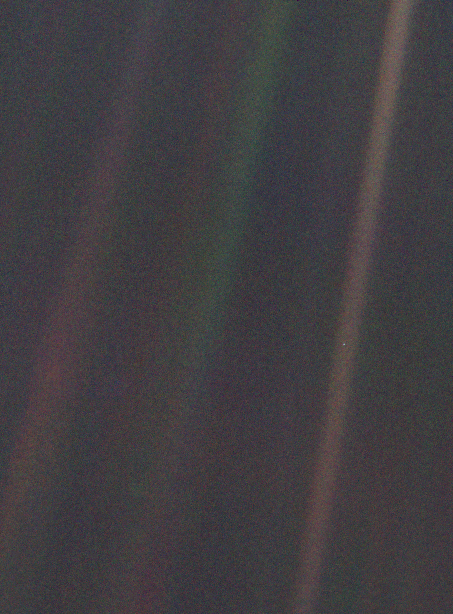 Adam Winnik studia Arti applicate e design allo Sheridan College, in Canada, e per la sua tesi finale ha deciso di illustrare un estratto del libro Pale Blue Dot del divulgatore scientifico Carl Sagan. Il “piccolo puntino azzurro” cui fanno riferimento il titolo del libro e l’animazione di Winnik è il nostro Pianeta fotografato venti anni fa a grande distanza da una sonda spaziale.
Adam Winnik studia Arti applicate e design allo Sheridan College, in Canada, e per la sua tesi finale ha deciso di illustrare un estratto del libro Pale Blue Dot del divulgatore scientifico Carl Sagan. Il “piccolo puntino azzurro” cui fanno riferimento il titolo del libro e l’animazione di Winnik è il nostro Pianeta fotografato venti anni fa a grande distanza da una sonda spaziale.
Nel 1990 Sagan propose alla NASA di far scattare una fotografia della Terra dalla sonda Voyager 1 che si trovava a circa sei miliardi di chilometri di distanza e in viaggio verso i confini del Sistema Solare. La foto, votata come una delle 10 migliori immagini scientifiche dello spazio di tutti i tempi, mostra un minuscolo punto azzurro nel buio del cosmo, la nostra casa. Quell’immagine così suggestiva ispirò profondamente Sagan e lo spinse a scrivere una serie di interessanti riflessioni sulla nostra esistenza su quel piccolo punto solitario nello spazio.
Winnik ha così selezionato uno dei passaggi più celebri del libro, letto direttamente da Sagan in un vecchio reading, ci ha aggiunto una colonna sonora di Hans Zimmer, che non guasta mai, e ha poi creato l’animazione.
From this distant vantage point, the Earth might not seem of any particular interest. But for us, it’s different. Consider again that dot. That’s here. That’s home. That’s us. On it everyone you love, everyone you know, everyone you ever heard of, every human being who ever was, lived out their lives. The aggregate of our joy and suffering, thousands of confident religions, ideologies, and economic doctrines, every hunter and forager, every hero and coward, every creator and destroyer of civilization, ever king and peasant, every young couple in love, every mother and father, hopeful child, inventor and explorer, every teacher of morals, every corrupt politician, every “superstar”, every “supreme leader”, every saint and sinner in the history of our species lived there — on a mote of dust suspended in a sunbeam.
The Earth is a very small stage in a vast cosmic arena. Think of the rivers of blood spilled by all those generals and emperors so that, in glory and triumph, they could become momentary masters of a fraction of a dot. Think of the endless cruelties visited by the inhabitants of one corner of this pixel on the scarcely distinguishable inhabitants of some other corner, how frequent their misunderstandings, how eager they are to kill one another, how fervent their hatreds.
Our posturings, our imagined self-importance, the delusion that we have some privileged position in the Universe, are challenged by this point of pale light. Our planet is a lonely speck in the great enveloping cosmic dark. In our obscurity, in all this vastness, there is no hint that help will come from elsewhere to save us from ourselves.
The Earth is the only world known so far to harbor life. There is nowhere else, at least in the near future, to which our species could migrate. Visit, yes. Settle, not yet. Like it or not, for the moment the Earth is where we make our stand.
It has been said that astronomy is a humbling and character-building experience. There is perhaps no better demonstration of the folly of human conceits than this distant image of our tiny world. To me, it underscores our responsibility to deal more kindly with one another, and to preserve and cherish the pale blue dot, the only home we’ve ever known.
